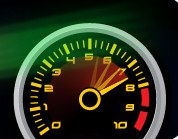 Hello everyone,
Hello everyone,
I am a “geek” and I also have an “obsessive–compulsive” personality. This is not always a good combination! I am very meticulous, absorbed, almost fixated with my computers appearance and performance, and believe me it’s very hard to be a perfectionist with a computer. You can clean, maintain, optimize, upgrade, and tweak a computer every minute of every day if you don’t “get a grip”. My wife has helped me to “chill out” a little and realize that my computer is, after all “just a machine”. Just a machine?! That’s easy for her to say but not for me (we bought her her own computer!).
There is so much unnecessary junk on computers these days that it drives me crazy. I feel so sorry for the uninformed users whose hard drives are full of bloated program files and whose computers are so slow that they can’t even work! I knew a guy who got up in the morning, turned on his computer, took a shower, ate breakfast, then returned to his computer which was just finishing to boot up. There has got to be a better way!! Luckily there is.
There are many ways to speed up your computer. Today I’m going to show you two ways that aren’t mentioned as much as some others.
1) Don’t allow your programs to auto-start when you turn on your computer. Start your programs when you want to not when they want to. Many programs will try to register themselves to run at system startup and you won’t even know it. Over time you’ll have like 30 programs starting up when you turn on your computer and your “boot time” will take forever. What to do?
A) Get Mike Lin’s StartupMonitor (http://www.mlin.net/StartupMonitor.shtml). Every time a program tries to sneakily register to run at startup, a small box will pop up on your screen and ask you if you want to allow this. Click NO every time!! I’ve been using StartupMonitor for years and at the moment I have TWO programs running at startup (one is StartupMonitor) and over TWENTY that have tried but have been “nixed” thanks to Mike Lin’s little program (you don’t even have to install it!).
B) If you have not been using StartupMonitor and you have no idea how many programs have registered to run at startup, get Mike Lin’s Startup Control Panel (http://www.mlin.net/StartupCPL.shtml) a “nifty control panel applet that allows you to easily configure which programs run when your computer starts”. The two programs StartupMonitor and Startup Control Panel compliment each other and go together like “two peas in a pod”.
2) Disable unnecessary services! Services are programs that run in the background and support specific functionality in the Windows OS. Third party programs can install services too. Many services that are running (by default or otherwise) are unnecessary and can be disabled. Disabling unneeded services will improve system resource usage, startup time, shutdown time and reduce unnecessary RAM usage. If you’re a “gamer”, disabling services will even reduce “stuttering” when you game. I counted 133 services in my Windows Vista box and I’ve disabled over half! What to do?
A) Go to “Black Viper” (http://www.blackviper.com). The day I found Charles “Black Viper” Sparks was an “Oh Happy Day”! Charles was off line for awhile but now he is back and he is No. 1 when it comes to service configuration. You’re going to have to read and study a little bit but it is well worth it. Charles gives you his service recommendations for Windows XP, Vista and Windows 7. Black Viper explains everything carefully and in an easy to understand way. I disabled my services one by one and I’ve never had any problems. I’m pretty much “bare bones” at the moment. My computer boots up in about 18 seconds (of course “obsessive–compulsive”)!
Professor Randy says: You control the computer – don’t let it control you!! Greatly increase your computing pleasure by eliminating unnecessary startup programs and unneeded services.


